12 very attractive contemporary garden ideas from RHS Hampton Court Garden Festival
One of the main reasons for visiting a show like the RHS Hampton Court Palace Garden Festival is to discover the best contemporary garden ideas. They don’t have to be obviously ‘modern’ – just to reflect how we think and feel about our gardens now.
Of course, having a huge range of garden-themed stalls means the shopping is fun. It’s an enjoyable day out.
And we all know that we can’t re-create ‘show gardens’ in our own garden. But it’s the ideas you can adapt for your own garden that make the day so worthwhile.

The almost completely recycled A Place to Meet Again garden, designed by Mike Long (top). Above is the Ability Garden, designed for easy access, by Tony Wagstaff and Ben Wincott.
What are the best contemporary garden ideas now?
- Replace manicured lawns and formal borders with vibrant, naturalistic planting
- Paths are informal, winding through planting with minimum hard landscaping or edging
- Re-wild the lawn or go no-lawn. Let some or all of the grass grow long.
- Recycle and upcycle – benches, fences, walls, pavers and ornaments
- Outdoor kitchens for luxury gardens
- No dig/no till is now mainstream – save time and your back!
- Prune multi-stemmed shrubs to create light at ground level
- Mix paver patterns on patios and terraces
- Long narrow ponds offer water features in smaller spaces
- Mix flowers and veg in the same beds
- Grow veg, fruit and herbs on walls and fences, and in pots
- Think sustainability, the environment and pollinator-friendly plants – know where your plants come from.
If you’d prefer to watch this on video, you can see The Top 10 Ideas for Your Garden from RHS Hampton Court Garden Festival here.
Focus on plants…but a ‘no border’ look
The two major set-piece show gardens, both sponsored by the RHS, focused on the plants. That may not sound revolutionary, but it is actually quite a significant shift in attitude. And it’s the one that will influence our own gardens most.
The RHS Garden for a Green Future, designed by Jamie Butterworth, had no formal borders at all. Think naturalistic planting and paths. There was no edging. And very little traditional hard landscaping. It doesn’t even have a lawn, just ‘tough meadow mixes’.
The garden was essentially mounds of plants, with paths apparently trodden through them to two chairs nestling by a pool.
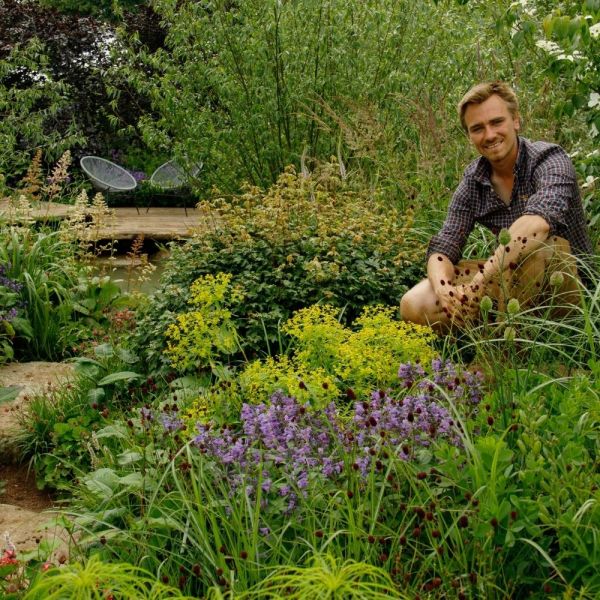
Jamie Butterworth in the RHS Garden for a Green Future. Photo by Lynn Keddie.
And the plants themselves are ‘resilient’ plants, such as Nepeta (Walkers Low and ‘Neptune’), salvias and phlomis.
The other big showcase garden was the RHS Iconic Horticultural Hero Garden. Designed by Tom Stuart-Smith, it also featured relaxed, natural planting and paths. Once again, the seating areas were barely more a clearing in the lush planting.

Top: the RHS Iconic Horticultural Hero Garden designed by Tom Stuart-Smith. Above: RHS Garden for a Green Future Garden, photo by Luke MacGregor.
Know where your plants come from…
The last few years have taught us that long supply chains are vulnerable to disruption. And we have also learned that where people – and plants – travel, disease travels with them. If you buy plants that have been ferried across borders, you are more likely to be importing a bio-security problem, such as a new pest or virus.
So these two big RHS showcase gardens have sourced their plants carefully or grown them themselves. The 7,000 plants for the RHS Garden for a Green Future were all grown in England by Jamie Butterworth’s company, Form Plants.
The 12,000 plants in the RHS Iconic Cultural Hero garden were grown by the Sunnyside Rural Trust, which provides training, work and work experience for people with learning disabilities. They grow a wide range of perennial plants from their four sites near Hemel Hempstead.
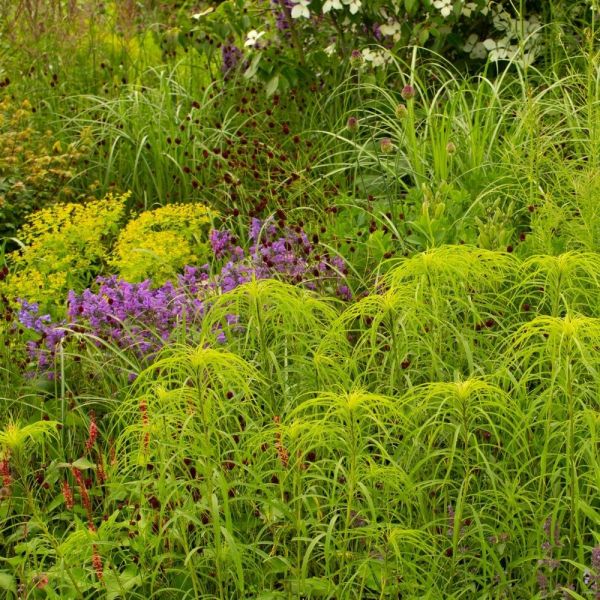
The 7,000 plants in the RHS Garden for a Green Future were grown in the UK by Form Plants. The plant in the foreground is Helianthus salicifolia. Photo by Lynn Keddie
There was also an emphasis on perennials plants and flowers, with full, lush lavish borders. To find out how to create this effect, see What You Need to Know to Create an Outstanding Perennial Border. And find out more about growing perennials in Perennials Made Simple and also 6 Perennial Flowers That Bloom All Summer.
Contemporary garden ideas – informal paths
This is one of those contemporary garden ideas that would easily shrink down to a small garden. You could establish a ‘naturally trodden path’ with bark chippings or mulch. Then fill most of the garden with planting. It would be an inexpensive, attractive and pollinator-friendly look.
This look is about maximising the natural world and minimising waste. So there’s no suggestion that anyone should take out their hard landscaping, paths or other structure.
The mounds in Jamie Butterworth’s Garden for a Green Future have theoretically been left there by the builders. In the past, soil would have been taken away. Now just plant on it (but be aware of where rain is going to run off, you don’t want damp problems).

The natural-looking path in Tom Stuart-Smith’s RHS Iconic Horticultural Hero garden. The plants in this garden were grown by the Sunnyside Rural Trust, which offers training and work experience for vulnerable people.
Essentially, the overall message is to increase the number of plants in your garden. And go for plants that do best where you are. The world’s weather is getting more erratic, so there’s no room for prized specimens that need special care. Plant easy spreaders and self-seeders.
There are plant lists for each garden on the RHS website. Several of the plants featured in Jamie Butterworth’s garden are mentioned in our 6 favourite perennial flowers that bloom all summer. They include Geranium psilostemon and Euphorbia ceratocarpa.
And think about ‘no lawn’…
‘No lawn’ is probably one of the fastest-growing contemporary garden ideas.
As our gardens get smaller, it’s harder to keep a lawn in good condition. For anyone with a garden of less than 50ft long, it’s more or less impossible.
But if you cover what was a traditional lawn area with concrete, stone or fake turf, that will be too much. Your garden is likely to be hotter, noisier and/or less sustainable and wildlife-friendly.
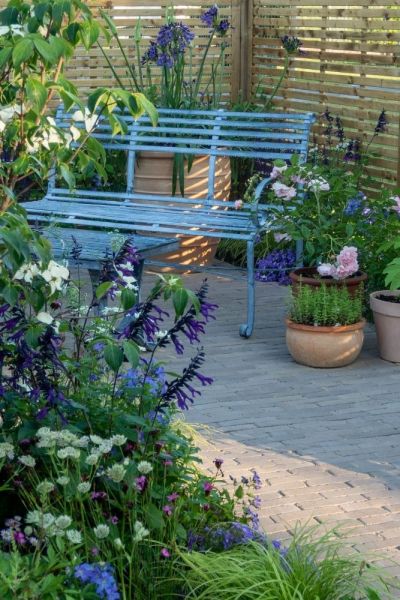
Charlies’ Courtyard starter garden, designed by Jane Scott Moncrieff, with lots of planting and a place to sit.
The solution is to create proportionately much larger borders, filled with plants. Then the rest can be a terrace or seating area, surrounded by colour and scent. So you’ll have larger borders and larger seating areas, but not as much open space as you’d get with a lawn.
Many of the prettiest gardens at RHS Hampton did this very well. Charlie’s Courtyard, designed by Jane Scott Moncreiff, was one of the Get Started Gardens for new gardeners. It shows how you can create big, frothy borders in a small space by using reliable, easy-to-find plants, such as Salvia ‘Amistad’ and Geranium ‘Rozanne.’ There’s a terrace with a bench and table in the middle of the garden.
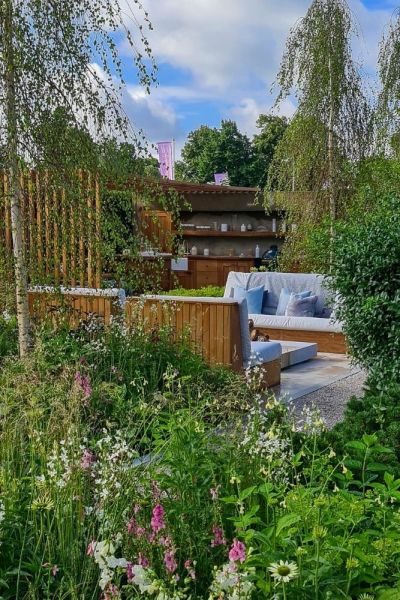
The Viking Cruises Friluftsliv garden, designed by Will Williams, with generous seating areas, lush, naturalistic planting and an outdoor kitchen.
And on a larger scale, the Viking Friluftsliv Garden was divided into living space and planting space, without a lawn.
Recycling ideas for your garden…
Sustainability was at the heart of the show. Recycling and upcycling are two of the most popular contemporary garden ideas.
Many of the show gardens took this beyond merely buying second-hand or vintage furniture. I particularly liked A Place to Meet Again, designed by Mike Long.
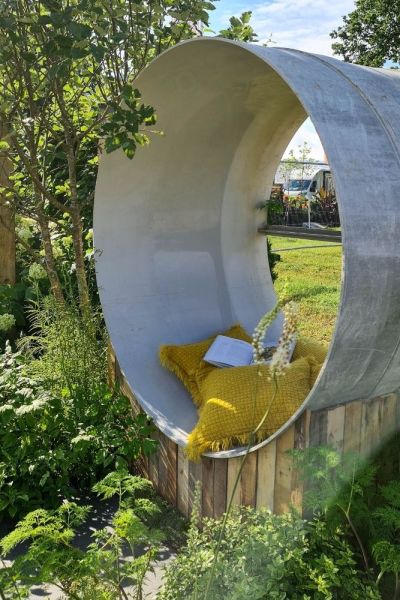
Upcycled water drainage pipes cut into a seat in the A Place to Meet Again garden, designed by Mike Long. The garden was built by the APL (the Association of Professional Landscapers.)
‘The garden is all about how we can re-purpose different items to save them going to landfill,’ Mike told me. The circular seat and water feature were both made with slices of rainwater drainage pipes. Within the water feature, we have old copper pipes and re-purposed taps. We’ve used scaffolding boards for decking, scaffolding poles to make a pergola and a RSJ to create a stepping stone across the water wheel. The bricks are made from 90% recycled materials.’
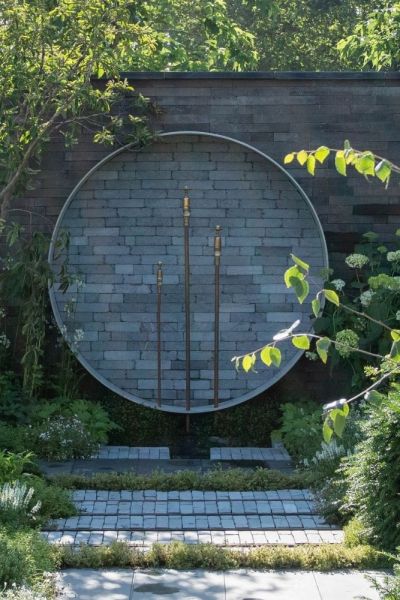
The bricks in the wall in the APL A Place to Meet Again garden are made from 90% recycled material. The water feature is another section of water pipe with reclaimed copper piping and brass taps. The pavers are also reclaimed.
The Punk Rockery Garden, designed by Amelia Bouquet, is also almost 100% recycled. There’s a pallet shelf, benches and fences from scaffolding boards and an upturned dustbin lid bird bath.
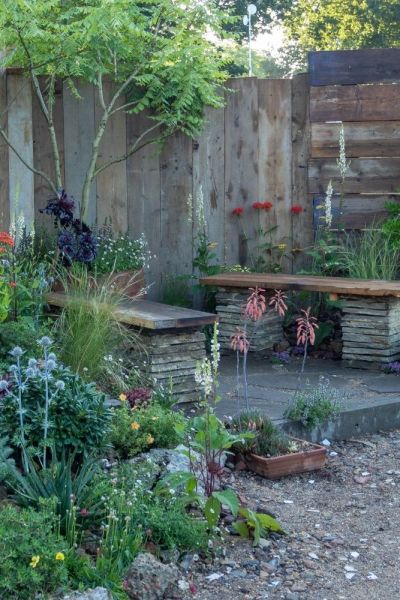
The Punk Rockery garden, designed by Amanda Grimes, is also almost 100% recycled. Materials include a scaffolding board fence with pallet shelves, broken paving and old concrete hard core and brick dust.
You can find more sustainable garden ideas in 3 very simple things you can do to create an eco friendly garden. And for more creative garden upcycling, see 15 ways to transform your garden with upcycled junk.
And above all, think before you rip your garden out completely, only to fill it with the latest designs. You can still have a very contemporary garden even if you leave many elements, trees and plants in place. See this garden with a sense of place for a contemporary garden which retains much of its past.
What every garden needs…an outdoor kitchen?
Outdoor kitchens are at the luxury end of contemporary garden ideas. I haven’t asked for any prices, but I know that installing an outdoor kitchen won’t be cheap.
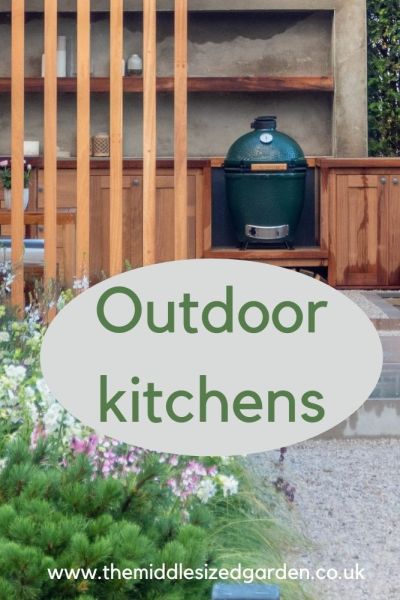
The outdoor kitchen in the Viking Friluftsliv garden.
But with today’s emphasis on entertaining outside, an outdoor kitchen promises a lot of fun. A few years ago, I spoke to Dan of the Frustrated Gardener blog about how he installed his outdoor kitchen. He gave me some excellent advice which still holds today.
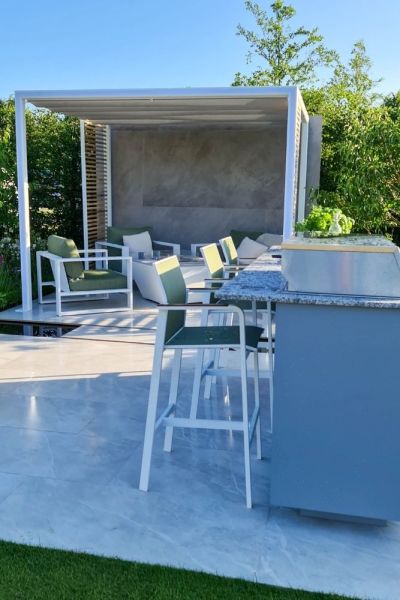
The outdoor kitchen in the Lower Barn Farm’s Bounce Back Garden designed by Samuel Moore.
No dig – better for you, better for the environment…
You’ll find No Dig (no till) methods of gardening easier. And they’re better for soil health. No Dig is one of those contemporary garden ideas that has been around for a long, long time. But it’s finally gone mainstream.
The RHS sponsored the RHS No Dig Allotment Demonstration Garden. Designed by Charles Dowding with Stephanie Hafferty of No Dig Home, it show-cased tightly planted seedlings, hot composting and planted up pallets, along with talks and demonstrations.
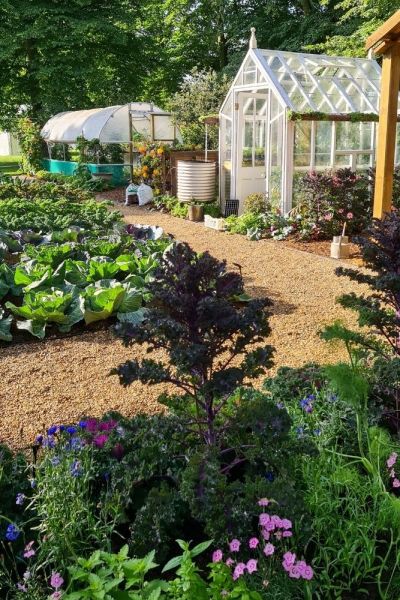
The RHS No Dig Allotment Garden, designed by Charles Dowding and Stephanie Hafferty
To find out about No Dig for Flower Borders, see my interview with Charles.
Prune shrubs into multi-stemmed shapes…
This is another trend that’s emerged for smaller gardens. These usually need more light at ground level. So one of the best contemporary garden ideas is to remove leaves and smaller branches from the lower parts of shrubs and trees. This gives a lovely multi-stemmed look.
Multi-stemmed trees and shrubs were everywhere at RHS Hampton. I’ve also been seeing it in ‘real gardens’ as well. At its simplest, this means removing the lower twigs, leaves and minor branches from a shrub to leave sculptural ‘legs’.
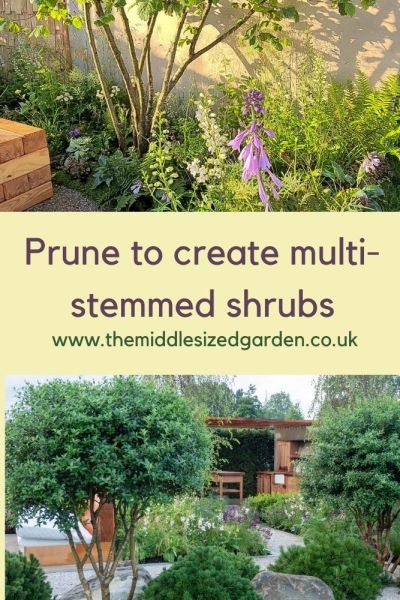
Multi-stemmed small trees or large shrubs in the Communications Garden (top), designed by Amelia Bouquet. And also above in the Viking Friluftsliv Garden, designed by Will Williams
If you want to turn a tree into a multi-stemmed tree, you can cut it down to the ground, so that it re-grows with several thinner trunks. It’s called coppicing and used to be done to provide wood. Check whether your tree will coppice successfully.
Many of the techniques in this post ‘How to Prune For Privacy and Light’ will work for multi-stemming trees and shrubs.
Mix patterns on pavers and terraces…
If you’re looking at less or no lawn, then you’ll be having larger planting beds and bigger terraces. So it can look good to break up a large expanse of hard surface with pattern. Mix the patterns of pavers and/or decking in your hard landscaping.
This can also be a good budget option. You may be able to get small amounts of different materials or leftovers from other people’s projects.
I saw this done beautifully in several gardens including the Viking Friluftsliv garden, designed by Will Williams, and the A Place to Meet Garden.
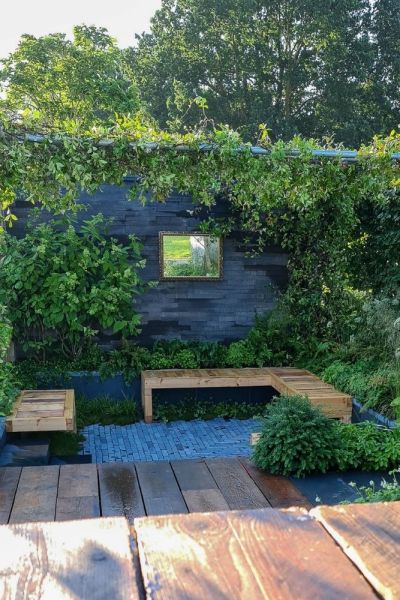
A mix of scaffolding board decking and recycled pavers in the APL A Place to Meet Again Garden. Designer Mike Long found the mirror on the side of the road, with a sign saying ‘free to a good home.
You can find out more about choosing materials, such as paths and pavers in gardens in this post here. It’s expensive to do hard landscaping, so it’s really worth thinking about which materials you use, even in a garden path.
Long narrow ponds…
Water is so important in a garden, particularly for wildlife. But, once again, many gardens are too small for a pond. If you have limited space, try a long, narrow pond alongside a terrace, boundary or border.
When these ponds first arrived on the design scene, I worried that people were going to step back into them while chatting with a glass of wine. And I’m sure they did.
Now designers have got round that by giving them a border or fitting them into planting.
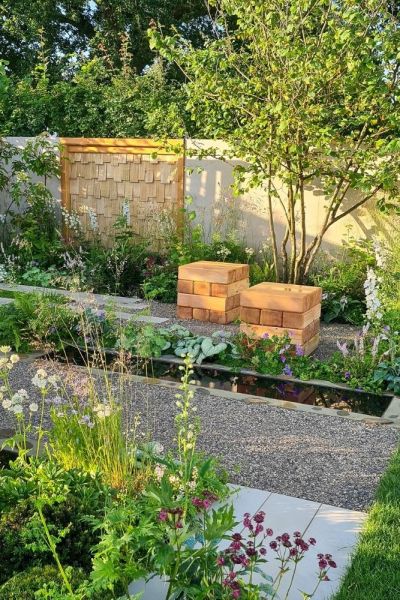
The Communication Garden, designed by Amelia Bouquet, featured two long narrow ponds, protected by planting and stones. This makes the best use of space in a small garden.
Find more pond design inspiration in 11 ideas from the best garden ponds I’ve seen.
Mix veg with flowers…
There’s been a huge growth in grow-your-own and allotment gardening. So the RHS expanded its grow-your-own area with 13 allotment show gardens.
Every allotment in the UK has its set of rules. You’re often not allowed to grow flowers, because allotments are for food growing. If you enjoy an argument, you can get stuck into this one with your allotment committee as so many flowers are edible. Dahlias, cannas, day lilies and hostas, for example…see more about edible flowers here.
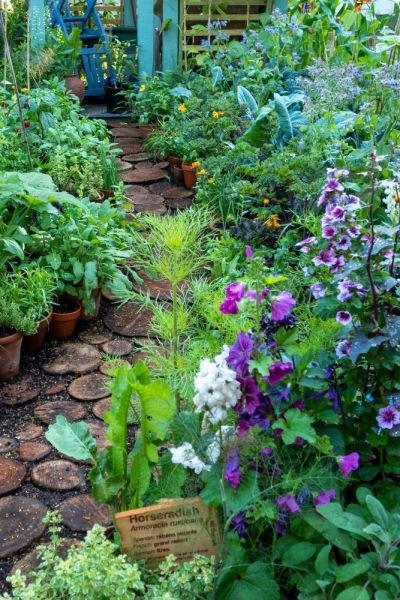
The Friends of Ascott Allotment mixed flowers and veg in a very attractive show garden in the allotment zone at RHS Hampton Court Garden Festival.
Most of the show allotment gardens mixed flowers and veg, especially the award-winning Growing More Than a Plot by the Friends of Ascott Community Gardens.
Grow fruit and veg in tiny spaces…
And Instagram ‘influencer, Lucy Hutchings of the She Grows Veg blog designed the Get Up and Grow Garden. This shows how you can grow veg on walls, in pots and in tiny spaces. Her garden included a number of vibrant is-it-a-flower/is-it-a-veg that you can show your allotment committee.
I am myself trying to decide where to place a vividly ornamental kale seedling gifted to me by Suttons Seeds.
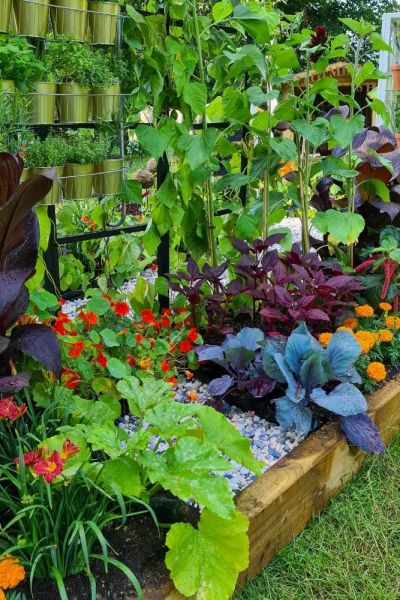
Lucy Hutchings (She Grows Veg on Instagram) showcased as many different ways of growing veg in a small space as possible. Plus she included flowers for a tropical vibe.
Even if you’re not interested in ‘trends’…
Many of us don’t ‘follow fashion’ in the strict sense. You may feel you don’t need to know about contemporary garden ideas. Whenever I write one of these posts, someone always tells me off on Twitter, because they think following fashion is trivial. Or irrelevant.
But wait. Trends – or fashion – is the context in which we live. It may be driven by technological advance, such as a new variant of a plant that’s resistant to disease.
And sometimes ‘trends’ come from us, particularly in the age of social media. Over lockdown, hundreds of thousands of people turned to growing their own vegetables. They posted their successes and failures on Instagram. Designers and organisations have picked that up, so it’s become part of the zeitgeist.
And fashion can also be a way of creating discussion around an issue. It can lead to real change, such as around sustainability. The past two years have shown us how fragile our way of life can be. Supply chains have been disrupted. Re-using, recycling and ‘making do’ are very much part of today’s contemporary gardens. And they fit into all kinds of garden styles, from cottage garden to urban outdoor room.
And you can find more garden design inspiration from the shows in 13 beautiful ideas for your garden from BBC Gardeners World Live. And although the garden shows often feature big budget concepts, you can also use them for ideas to update your garden on a budget.
Pin to remember contemporary garden ideas
And do join us for free weekly emails with tips, ideas and inspiration for your garden. See here for more details.

























I enjoyed your post and am with you on most things. I’m not ready to give up my lawn yet although I have visited many charming no-lawn gardens. There seem to be many attractive ways of fencing out there too.
I think the lawn issue is very much one of personal taste – I love seeing the butterflies on the shaggy lawn, but I also think the smart green lawn shows off a border beautifully.
An important, often difficult, part of letting go of that clean, green lawn is overcoming that ‘it should look tidy’ urge. We’re conditioned to seeing ‘wild’ as untidy, the mark of a lazy gardener. A year after reliquishing control over my front lawn I still get the urge to tidy it up. But then I notice it’s alive with bustling population of insects and put the control freak back in its box.
Well done to the control freak….I think it’s quite a difficult balance and different for each of us, I’m grappling with the same issues with my front lawn at the moment.